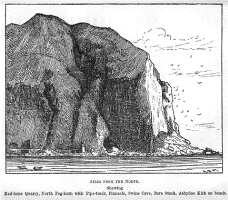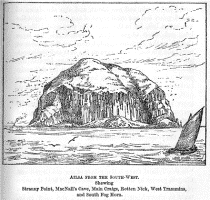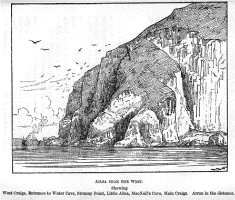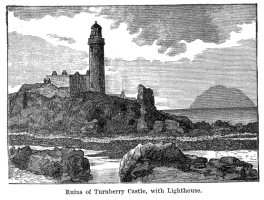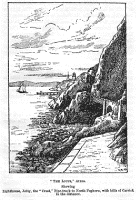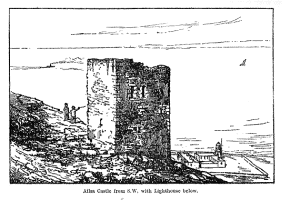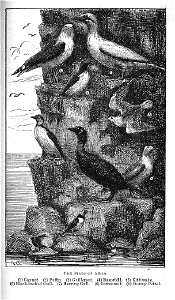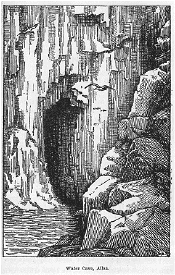|
|||||||||||||||
|
The sketches below and introductory text that follows are from the book AILSA CRAIG by the Reverend Roderick Lawson. It was published in 1888 and remains a popular and republished book about the island to this day. Click here for colour photos or here for a map and complete topographical details. |
|||||||||||||||
|
|||||||||||||||
|
|||||||||||||||
|
The outline of Ailsa, as seen from Ayr on the north, or from Ballantrae on the south, has somewhat of a sugar-loaf appearance, but from the opposite coast of Girvan, this outline is flattened into the shape of a huge tea-cosy, or an immense cover for encompassing a round of beef. From the south end of Arran, its solitariness in the waste of waters is what most strikes a spectator, and this has caused it to receive the nickname of Paddy's Milestone, while the superstitious fancies of our forefathers have attributed its origin to the Prince of Darkness, or his emissaries the witches, who, in passing over to Ireland, dropped our islet on the way. The hill of Knockdolian in Colmonell parish, which may be seen from Ailsa, resembles it somewhat in appearance, and has received from sailors the name of "the false Craig." The most notable feature of Ailsa is the abruptness with which it rises from the sea. It is evidently of volcanic origin; and while most islands have more or less of a flat surface near the shore, Ailsa has none. Indeed, were it not for a bank of shingle which, in course of ages, the tides have washed up on the east side, and the fallen rocks which form a range of buttresses on the other sides, Ailsa would have been inaccessible. In "unattended majesty" our little island springs at once into the air from the level surface of the ocean, and impresses a sense of awe on every near-at-hand spectator. Like most prominences, too, that face the sea, it is of "Crag-and-tail" formation; the steep sides fronting the ocean, and the sloping sides the land. According to the measurements of the Ordnance Survey, Ailsa is 3,900 feet in length (or a little over 3/4 of a mile); 2,600 feet in breadth (or a little over 1/2 of a mile); and 1,114 feet in height (or somewhat less than 1/4 of a mile).(2). In circumference, it is rather more than 21 miles, and it covers an area of 220 acres. The spit of level ground on the east side, where the houses stand, measures 30 acres, and is composed of water-worn stones with a little moss interspersed The nearest part of the mainland is Ardwell point, Ayr-shire, 81/2- miles; Girvan is 91/2 miles distant; Turnberry 11 1/2 miles; Pladda in Arran 12 miles; Corsewall point in Wigton, 17 miles; and the nearest part of Ireland, 36 miles. Ailsa is situated in latitude 55°15" North, and longitude 5°6" West; and as lighthouses are required to keep sun-time, it follows that Ailsa time is 20 1/2 minutes slower than that of Greenwich. For the same reason Irish time is 23 minutes behind ours. No one can help being struck with the beautiful name of our island. Indeed, it almost matches Iona in liquid smoothness. But what its meaning may be, has puzzled etymologists. The late Dr. Macleod of Morven informed me that the full name of Ailsa in Gaelic is Ailishair-a-Chuain, which probably means, Island of sea fowl. But other Gaelic scholars have advocated other etymologies. Plainly the word is of Celtic origin, as indeed are most of the names in this part of Scotland. On Ailsa itself, there are various localities known by Gaelic names, such as Biorach Stac (pronounced Bare Stack), Ashydoo, Garryloo, The Trammins, Clashwaun, Balvar, Craigna'an, &c. I have tried to get at the meaning of these, but have found the uncertainty so great as to make me willing to rest content in the names themselves, without seeking to inquire further.(3) Ailsa, with its lighthouse, cannot of course now be thought of as an uninhabited island, but in former days when no one lived on it except the tenant, the situation must have been dreary in the extreme. On stormy nights, when the winds were out and the waves thundering on the beach, the Ailsa hermit, sitting by his lonely ingle, must, one would have thought, have felt his isolation keenly. And yet, familiarity breeds contempt; for one of those tenants, on being asked whether he did not feel lonely on stormy nights, oddly replied that he had never felt lonely except once, and that was when the clock stopped ticking; and then, for the first time, he became conscious of what he called "the noise outside." (1) In the summer of 1818, John Keats and a friend named Brown undertook a pedestrian tour through Scotland. They travelled along the Ayrshire coast from Ballantrae northwards, Ailsa Rock being constantly in their view. "That fine object," says Lord Houghton, "appeared first to them in the full sunlight like a transparent tortoise asleep upon the calm waters; then as they advanced, displaying its lofty shoulders, and as they still went on, losing its distinctness in the mountains of Arran and the hills of Cantire that rose behind it." At the King's Arms Inn in Girvan, Keats wrote his fine sonnet on Ailsa Craig. (2) Knockdolian, 869 ft.; Mochrum, 886 ft.; Saugh hill, 970 ft.; Goat Fell, 2865 ft. (3) Dr Currie of Wemyss Bay, of those whom I have consulted, seems to have made the best attempts. According to him Ailsa means Rocky isle (from AjU, a cliff, and a an island, as in Sanda, Pladda, &c). Craigna'an, cliff of birds; Biorach Stac, jutting-out cliff; Clashwaun, white trench (from Clais, a trench); Garryloo, rough hill; Ashydoo, black hill; Balvar, big round cliff; Trammins, place of Elder bushes. This name is pronounced Trammells on the Craig, but it is evidently a mistake, as the etymology shews. |
|||||||||||||||




